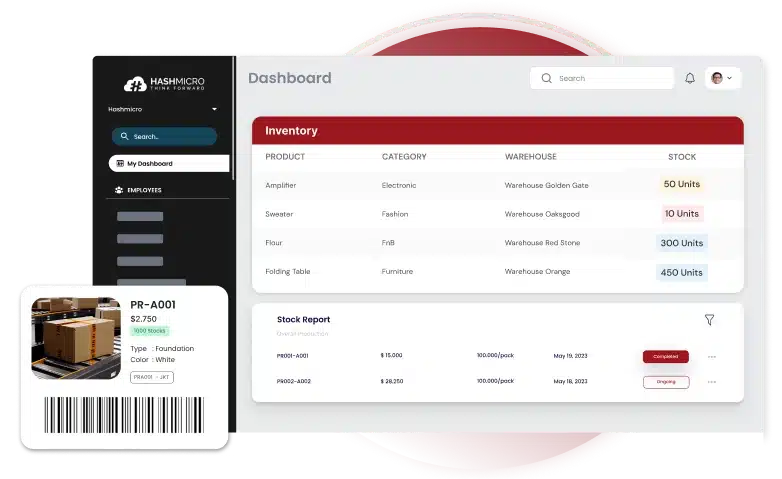In retail, one critical factor can spell the difference between your business thriving or merely surviving: effective retail inventory management. Overlooking this aspect—especially if you’re also juggling production—can lead to severe losses.
Inventory is the heartbeat of any retail company worth its salt; if it’s not properly managed, it will drain your resources, squander valuable products, and put everything you’ve worked hard to build at risk.
But don’t worry; this is a challenge you can easily overcome.
In this article, we explore the essentials of retail inventory management and offer best practices for helping you and your team manage inventory like pros, ensuring your business not only survives but also thrives.
Key Takeaways |
Table of Content:
Table of Content
What is Retail Inventory Management?
Retail inventory management is the process of retailers having the right amount of merchandise to meet customer demand without overstocking. As such, it involves estimating inventory levels, managing stock across sales channels, and tracking product location, quantity, and sales patterns.
Effective retail inventory management helps retailers minimize costs and optimize stock levels. In addition, it also contributes to improving their understanding of which products sell well by location and sales channel.
Retail and inventory management tools and methods also give insight to retailers about the following processes:
- storing and shipping goods
- determining how often to reorder
- when to discontinue products
- how seasonal changes impact sales
Additionally, inventory management software helps in valuing goods for accounting and auditing purposes, ultimately ensuring that retailers can meet customer needs while minimizing the cost of storing unsold goods.
Benefits of Retail Inventory Management
Retail inventory management is essential for ensuring that the right products are available when customers need them, all while controlling costs. By mastering inventory practices, retailers can unlock key benefits that boost profitability and efficiency.
Below, we outline the significant advantages of effective retail inventory management:
- Cost savings: By fine-tuning your inventory levels, you can slash holding inventory costs and dodge the losses of overstocking or stockouts. Deloitte highlights that using advanced analytics in retail inventory management can reduce carrying costs by up to 30%.
- Enhanced customer satisfaction: Nothing frustrates customers more than finding their desired product out of stock. Smart inventory management ensures you have what they want when they want it. According to Statista, 44% of retailers who adopted inventory solutions saw a boost in demand planning and customer satisfaction.
- Boost efficiency: Streamlining your inventory processes doesn’t just save time; it frees up your team to focus on what matters. Gartner’s recent research shows that effective inventory management can significantly reduce inventory levels and improve retail asset management.
- Better decision-making: With accurate inventory data, you can spot trends, forecast demand, and make decisions that drive your business forward. This study underscores the importance of KPIs in delivering actionable insights for more thoughtful, faster decision-making.
Types of Retail Inventory
Inventory management involves tracking goods from the manufacturer to the distributor, retail warehouse, and retail outlet. It may also include managing partially assembled goods and maintenance items. Here’s a breakdown of different types of goods that may need to be inventoried:
- Raw materials: These are the essential components or ingredients used to create the final product, such as steel, wood, cotton, or plastic. Proper management of raw materials is crucial for maintaining smooth manufacturing operations.
- Work-in-progress (WIP) items: WIP inventory includes materials that are being manufactured but are not yet finished. This can consist of partially assembled products or components still being worked on. The value of WIP inventory considers materials, labour, and overhead costs.
- Work-in-process (WIP) items: Work-in-process inventory includes materials that have undergone some transformation but are not yet ready for sale. For example, in the coffee industry, WIP inventory may include roasted beans, packaging materials, and boxes awaiting shipment.
- Finished goods: These products have been entirely manufactured, packaged, and are ready for sale.
- Maintenance, repair, and operations (MRO) goods: MRO items are used for maintaining and repairing equipment and facilities. Examples include tools, spare parts, and cleaning supplies.
- Packaging materials: These materials, such as boxes, cartons, labels, and packing peanuts, are used to package and protect products during transportation.
Retail Inventory Management Techniques
Inventory management involves tracking, storing, and restocking goods to ensure customers can find their needs. Here are six techniques retailers use to manage their inventories effectively:
- Inventory valuation: This technique involves assigning a monetary value to inventory based on the cost of producing or acquiring the items. Factors like anticipated discounts, taxes, and storage fees are included in this valuation, which is essential for tax accounting and reporting.
- Regular reconciliation: Retailers compare inventory counts in different systems with actual physical counts to ensure accuracy. This process keeps inventory records up-to-date and reliable.
- Physical inventory counts: Retailers manually count all inventory across warehouses, stores, and locations and compare the numbers to their records. Though time-consuming and often disruptive, this method is usually done annually to resolve any discrepancies before the new financial year begins.
- Cycle counts: Rather than counting everything at once, retailers regularly count small inventory sections throughout the year. This method is less disruptive and helps identify issues as they arise, keeping inventory records accurate over time.
- ABC analysis: This method ranks products from A to C based on their financial significance, with “Class A” items being the most valuable. Retailers use this ranking to prioritize which items should be counted more frequently.
- Spot checks: Similar to a mini-cycle count, retailers randomly select items from inventory to compare against accounting records. Spot checks help uncover any discrepancies in inventory management.
Managing inventory effectively is vital for retail success, but it can be siong without the right tools. HashMicro’s retail inventory software simplifies these processes with real-time insights, automated reconciliation, and seamless integration.
With cloud-based inventory solutions, retailers get better visibility, better accuracy, and better control over stock levels. Retailers can see how the software enhances inventory management by trying a free demo.
How Does Retail Inventory Management Work?
Inventory management is an essential yet often overlooked part of retail business. It involves maintaining sufficient stock to satisfy customer demand without overstocking, which could lead to financial losses due to carrying costs like rent and transportation.
Effective retail inventory management involves establishing systems to record products, receive them into inventory, monitor changes during sales, oversee the movement of goods from purchase to final sale, and verify stock counts.
Below are the basic steps on how retail operations, especially in inventory work:
1. Create a Centralized Record of All Products
The first step in effective inventory management is creating a centralized record of all products. This record should include every item you carry and essential details such as:
- product name
- SKU
- brand
- size
- price
- location
- vendor information
Additionally, including reorder quantities, product images, and descriptions helps staff quickly identify items. Regular updates to this record are crucial, especially when there are changes in vendors or prices.
2. Identify Stock Locations
Identifying the location of your stock is vital for preventing lost sales due to misplaced products. For small businesses with a single store, this process is straightforward.
However, larger retailers with multiple locations or omnichannel operations must track inventory across various sites like warehouses, distribution centers, and stockrooms.
Technologies such as RFID tags, barcodes, and labels can automate this process, ensuring that products are accurately mapped and easy to locate. Make sure to pair it with logistics management software for an integrated approach.
3. Perform Regular and Accurate Stock Counts
Regular stock counts are essential to maintaining accurate inventory records. By periodically counting your inventory, you can verify stock levels and account for any shrinkage, damage, or returns.
A retail inventory management system helps focus on discrepancies rather than starting from scratch by using an inventory report. While the frequency of counts may vary depending on your business’s complexity, experts recommend performing them at least annually or quarterly.
4. Combine Sales Data with Inventory Data
Integrating sales data with inventory data provides valuable insights into your stock’s performance. This combination helps you identify which products are selling quickly and which are lagging.
Using this information, you can decide when and how much to reorder and plan promotions or discounts to boost sales.
5. Establish a Structured Purchasing Process
A well-organized purchasing process is crucial for effective inventory management. Reviewing inventory data regularly and setting reorder points helps you avoid stockouts and stay ahead of seasonal trends.
Automated alerts for low stock levels ensure you’re always prepared, while manual reviews allow you to prioritize purchases based on profitability and lead times.
6. Plan for Markdowns and Promotions
Planning for markdowns and promotions is essential to managing inventory effectively. Not all products will meet sales expectations, and markdowns can help move slow-selling items, freeing up space for more profitable ones.
A well-thought-out promotion strategy ensures you have enough stock to meet demand without overextending your inventory.
7. Create a Stock Receiving Procedure
A clear and consistent stock-receiving procedure is vital to avoiding errors and maintaining inventory accuracy. When receiving goods, verify incoming orders against purchase orders, and inspect products for any damage or discrepancies.
Enter the new stock into your inventory system promptly, and address any issues with vendors immediately. This routine reduces the risk of unexpected stockouts or overpayments to suppliers.
8. Implement a Return Process
Handling customer returns efficiently is crucial to maintaining accurate inventory levels. When a return is made, check the item for damage or defects and decide whether to repair, write off, or restock it. Then, ensure that sellable items are quickly returned to inventory and placed in their correct locations.
9. Manage Dead Stock
Excess or unsellable inventory, such as damaged goods or outdated seasonal items, can tie up capital and reduce profitability.
To manage dead stock effectively, regularly identify and remove it from your inventory. Return items to vendors for credit or find alternative ways to dispose of them, such as selling to outlets or donating.
10. Track Key Performance Indicators (KPIs)
To gauge the success of your inventory management process, it’s essential to track key performance indicators (KPIs) like profitability, inventory value, sell-through rate, and turnover rate. Monitoring these metrics allows you to make data-driven decisions and continuously improve your inventory strategies.
You can also read additional articles related to MEIO to gain a deeper understanding of its strategic applications and the significant benefits it offers for supply chain management.
Best Practices of Retail Inventory Management
Retailers who embrace best practices in inventory management lay the groundwork for greater stock accuracy, reduced costs, less shrinkage, and higher profit margins. Adhering to industry standards and heeding expert advice can boost your business’s success.
1. Optimize Your Ordering Process
Make sure you’re ordering just the right amount of stock at the right time to meet demand and keep customers happy. This involves setting data-driven levels for safety stock and par stock, knowing your reorder thresholds, optimizing order sizes with economic order quantity (EOQ), and using the open-to-buy technique for purchase planning. Get this right, and your inventory will run like a well-oiled machine.
2. Take Charge of Your Supply Chain
Don’t just sit back; take charge of your supply chain. Share your sales and product forecasts with vendors and ask them for precise lead times. Keep an eye on suppliers’ service levels, like the percentage of complete orders and fulfillment times.
If a vendor isn’t up to par, communicate your expectations clearly and outline the steps they need to take to improve. Also, always have a backup plan by identifying alternative suppliers for your most critical items—don’t wait until you’re caught off guard.
3. Analyze Your Metrics
Keep a close watch on your key performance indicators (KPIs). Track which products are your best and worst performers using analysis methods like ABC, FSN, or XYZ. Understand the signs of customer demand and seasonal changes, and stay on top of your turnover rate and GMROI.
Continuously work to improve the accuracy of your customer demand and sales forecasts. After all, you can’t manage what you don’t measure, right?
4. Enhance Operational Efficiency
Efficiency is the game’s name, so never stop striving to make every part of your inventory management process smoother. Organize your warehouse strategically and keep it tidy. Consider these tips for boosting efficiency:
- Choose the picking process that best suits your order volume and product types.
- Store items close to the regions where they are in the highest demand.
- Explore whether drop shipping or a third-party logistics provider could streamline your inventory management.
- Fight shrinkage with loss prevention programs and closely monitor incoming goods.
- Use SKU management to analyze carrying costs.
- Ensure you’re offering the right number of products and identify your fastest-moving items.
- Document all processes, like receiving, to maintain consistency.
5. Focus on Precision
Accuracy, accuracy, accuracy—can’t stress it enough! Conduct regular inventory audits and counts, train your staff in inventory management, and set clear performance goals. Foster a culture that values precision because, at the end of the day, accurate inventory is the key to smooth operations. Don’t play play when it comes to this.
6. Leverage Inventory Management Technology
Embrace technology to automate tasks and make swift progress on goals like accuracy and efficiency. The right tool can integrate your point-of-sale (POS) system with inventory management, eliminating manual data entry and reducing errors.
Automated inventory management software also sends stock alerts and simplifies coordination across multiple locations, making your job much easier. It’s the upgrade that makes you wonder how you ever managed without it.
Leverage Your Retail Stocks with HashMicro Retail Inventory Software
HashMicro offers an all-in-one solution for retailers who want to streamline inventory management. Imagine having an automated system that tracks your stock, saves time, cuts costs, and minimizes errors—steady lah, sounds like a game-changer, right?
You can efficiently monitor inventory movements with Hash Retail Innovation. Every time a product is added or sold, your records update instantly. No more guesswork about when to reorder—everything is updated in real time, so nothing slips through the cracks.
This system improves efficiency and saves your business money. By reducing errors and time spent on manual data entry, you can create a more productive and cost-effective operation. Really, it’s a win-win!
HashMicro provides all the tools you need to take control of your inventory:
- Smart Stock Control: Gain valuable insights with FSN, XYZ analysis, and inventory turnover tracking to keep everything running smoothly.
- Seamless Operations: From procurement to sales, ensure your stock is always well-managed and readily available.
- Effortless Multi-Unit Handling: Manage product variations, create bundles, and track expiration dates with ease.
- Total Control: Streamline your processes for returns, warranties, and consignment inventory—everything is well-organized and under control.
- Boost Your Business: Enhance your retail success with inventory management that’s efficient and effective
If you’re serious about optimizing your retail inventory management, investing in HashMicro’s solution is the way forward. You’ll be amazed at how much time and money you can save.
For a comprehensive approach to managing your inventory, try a free demo of HashMicro’s software and see the difference it can make!
FAQ About Retail Inventory Management
-
How do retail stores maintain inventory?
1. Utilize ABC analysis to prioritize inventory.
2. Predict demand accurately.
3. Set clear KPIs.
4. Improve inventory turnover.
5. Determine precise reorder points.
6. Maintain safety stock levels.
7. Streamline pick and pack operations.
8. Implement lot tracking for better inventory control. -
What is the retail inventory method?
The retail inventory method is an accounting technique that allows business owners to estimate their inventory’s value over a specific period. Typically calculated at the close of an accounting period, this method helps retailers approximate the worth of their ending inventory.
-
How do you solve retail inventory method?
The retail inventory method determines the ending inventory’s value by summing the value of available goods, including beginning inventory and new inventory purchases. The total sales for the period are then deducted from the available goods to calculate the ending inventory value.
-
What is the retail inventory life cycle?
The four stages of retail—emerging, growing, maturing, and decline—are crucial for business success. To thrive, a company should focus on these stages while also adhering to the four pillars of retail: pricing, selection, convenience, and customer experience.







































